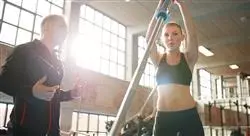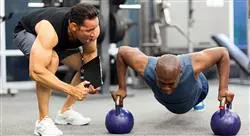University certificate
Scientific endorser

The world's largest faculty of sports science”
Description
This 100% online Postgraduate diploma will enable you to balance your studies while increasing your knowledge in this field”
In recent years, strength training has burst with great impetus in the scientific community, covering multiple contexts ranging from sports performance in time and brand sports, to situational sports through the whole range of sports modalities.
This Postgraduate diploma addresses the vital importance of strength in human performance in all its possible expressions with a unique level of theoretical depth and a level of descent to the practical totally different from what has been seen so far.
The student of this Postgraduate diploma will have a differentiating education with respect to their professional colleagues, being able to perform in all areas of sport as a specialist in Strength Training.
The teaching team of this Postgraduate diploma in Performance Evaluation and Strength Sports Training has made a careful selection of each of the topics of this training to offer the student a study opportunity as complete as possible and always linked to current events.
Asia, TECH Global University has set out to create contents of the highest teaching and educational quality that will turn students into successful professionals, following the highest quality standards in teaching at an international level. Therefore, we is shown this Postgraduate diploma with a rich content that help you reach the elite of physical training. In addition, as it is an online Postgraduate diploma, the student is not conditioned by fixed schedules or the need to move to another physical location, but can access the contents at any time of the day, balancing their work or personal life with their academic life.
Immerse yourself in the study of this Postgraduate diploma of high scientific rigor and improve your skills in strength training for high performance sports"
This Postgraduate diploma in Performance Assessment and Strength Training contains the most complete and up-to-date scientific program on the market. The most important features include:
- The development of numerous case studies presented by specialists in personal training
- The graphic, schematic and practical contents of the course are designed to provide all the essential information required for professional practice
- Exercises where the self -assessment process can be carried out to improve learning
- Algorithm-based interactive learning system for decision making
- Special emphasis on innovative methodologies in personal training
- Theoretical lessons, questions to the expert, debate forums on controversial topics, and individual reflection assignments
- Content that is accessible from any fixed or portable device with an Internet connection
This Postgraduate diploma is the best investment you can make when selecting a refresher program, for two reasons: in addition to updating your knowledge as a personal trainer, you will obtain a qualification from TECH Global University"
The teaching staff includes professionals from the field of sports science, who bring their experience to this training program, as well as renowned specialists from leading societies and prestigious universities.
The multimedia content, developed with the latest educational technology, will provide the professional with situated and contextual learning, i.e., a simulated environment that will provide immersive education programmed to learn in real situations.
This program is designed around Problem-Based Learning, whereby the professional must try to solve the different professional practice situations that arise during the course. To do so, the professional will be assisted by an innovative interactive video system developed by renowned and experienced experts in Performance Evaluation and Strength Sports Training.
Specialize and stand out in a sector with high demand for professionals"
Increase your knowledge in Performance Assessment and Strength Training with this high-level program"
Syllabus
The structure of the syllabus has been designed by a team of professionals with knowledge of the implications of training in daily practice, who are aware of the relevance of the up-to-date quality training in the field of personal training, and are committed to quality teaching using new educational technologies.
We have the most complete and up-to-date scientific program on the market. We want to provide you with the best training"
Module 1. Performance Assessment and Strength Training
1.1. Assessment
1.1.1. General Concepts on Assessment, Test and Measuring
1.1.2. Test Characteristics
1.1.3. Types of Tests
1.1.4. Assessment Objectives
1.2. Neuromuscular Technology and Assessments
1.2.1. Contact Mat
1.2.2. Strength Platforms
1.2.3. Load Cell
1.2.4. Accelerometers
1.2.5. Position Transducers
1.2.6. Cellular Applications for Neuromuscular Evaluation
1.3. Submaximal Repetition Test
1.3.1. Protocol for its Assessment
1.3.2. Validated Estimation Formulas for the Different Training Exercises
1.3.3. Mechanical and Internal Load Responses During a Submaximal Repetition Test
1.4. Progressive Maximum Incremental Exercise Test (IETmax)
1.4.1. Naclerio and Figueroa Protocol 2004
1.4.2. Mechanical (linear encoder) and internal load (PSE) responses during one TPI max
1.4.3. Determination of the optimal zone for power training
1.5. Horizontal Jump Test
1.5.1. Assessmen Without Using Technology
1.5.2. Assessment using technology (Horizontal Encoder and Force Platform)
1.6. Simple Vertical Jump Test
1.6.1. Squat Jump (SJ) Assessment
1.6.2. Counter Movement Jump Assessment
1.6.3. Assessment of an Abalakov Salto ABK
1.6.4. Drop Jump (DJ) Assessment
1.7. Rebound Jump Test
1.7.1. 5-second Repeated Jump Test
1.7.2. 15-second Repeated Jump Test
1.7.3. 30-second Repeated Jump Test
1.7.4. Fast Strength Endurance Index (Bosco)
1.7.5. Effort Exercise Rate in the Rebound Jump Test
1.8. Mechanical Responses (Strength, Power and Speed/Time) During Single and Repeated Jumps Tests
1.8.1. Strength/Time in Simple and Repeated Jumps
1.8.2. Speed/Time in Single and Repeated Jumps
1.8.3. Power/Time in Simple and Repeated Jumps
1.9. Strength/Speed Profiles in Horizontal Vectors
1.9.1. Theoretical Basis of an S/S Profile
1.9.2. Morin and Samozino Assessment Protocols
1.9.3. Practical Applications
1.9.4. Contact Carpet, Linear Encoder and Force Platform Evaluation of Forces
1.10. Strength/Speed Profiles in Vertical Vectors
1.10.1. Theoretical Basis of an S/S Profile
1.10.2. Morin and Samozino Assessment Protocols
1.10.3. Practical Applications
1.10.4. Contact Carpet, Linear Encoder and Force Platform Evaluation of Forces
1.11. Isometric Tests
1.11.1. McCall Test
1.11.1.1. Evaluation Protocol and Values Recorded With a Force Platform
1.11.2. Mid-Thigh Pull Test
1.11.2.1. Evaluation Protocol and Values Recorded With a Force Platform
Module 2. Strength Training in Situational Sports
2.1. Basic Fundamentals
2.1.1. Functional and Structural Adaptations
2.1.1.1. Functional Adaptations
2.1.1.2. Load-Pause Ratio (Density) as a Criterion for Adaptation
2.1.1.3. Strength as a Base Quality
2.1.1.4. Mechanisms or Indicators for Structural Adjustments
2.1.1.5. Utilization, Conceptualization of the Muscular Adaptations Provoked, as an Adaptive Mechanism of the Imposed Load. (Mechanical Stress, Metabolic Stress, Muscle Damage)
2.1.2. Motor Unit Recruitment
2.1.2.1. Recruitment Order, Central Nervous System Regulatory Mechanisms, Peripheral Adaptations, Central Adaptations Using Tension, Speed or Fatigue as a Tool for Neural Adaptation
2.1.2.2. Order of Recruitment and Fatigue During Maximum Effort
2.1.2.3. Order of Recruitment and Fatigue During Submaximal Effort
2.1.2.4. Fibrillar Recovery
2.2. Specific Fundamentals
2.2.1. Movement as a Starting Point
2.2.2. Quality of Movement as a General Objective for Motor Control, Motor Patterning and Motor Programming
2.2.3. Priority Horizontal Movements
2.2.3.1. Accelerating, Braking, Change of Direction With Inside Leg and Outside Leg, Maximum Absolute Speed and/or Sub-Maximum Speed Technique, Correction and Application According to the Specific Movements in Competition
2.2.4. Priority Vertical Movements
2.2.4.1. Jumps, Hops, Bounds. Technique, Correction and Application According to the Specific Movements in Competition
2.3. Technological Means for the Assessment of Strength Training and External Load Control
2.3.1. Introduction to Technology and Sport
2.3.2. Technology for Strength and Power Training Assessment and Control
2.3.2.1. Rotary Encoder (Operation, Interpretation Variables, Intervention Protocols, Application)
2.3.2.2. Load Cell (Operation, Interpretation Variables, Intervention Protocols, Application)
2.3.2.3. Strength Platforms (Operation, Interpretation Variables, Intervention Protocols, Application)
2.3.2.4. Electric Photocells (Operation, Interpretation Variables, Intervention Protocols, Application)
2.3.2.5. Contact Mat (Operation, Interpretation Variables, Intervention Protocols, Application)
2.3.2.6. Accelerometer (Operation, Interpretation Variables, Intervention Protocols, Application)
2.3.2.7. Applications for Mobile Devices (Operation, Interpretation Variables, Intervention Protocols, Application)
2.3.3. Intervention Protocols for the Assessment and Control of Training
2.4. Internal Load Control
2.4.1. Subjective Load Perception by Rating the Perceived Exertion
2.4.1.1. Subjective Perception of Load to Estimate Relative Load (% 1MR)
2.4.2. Scope
2.4.2.1. As Exercise Control
2.4.2.1.1. Repetitions and PRE
2.4.2.1.2. Repetitions in Reserve
2.4.2.1.3. Scale of Speed
2.4.2.2. Controlling the Overall Effect of a Session
2.4.2.3. As a Tool for Periodization
2.4.2.3.1. Use of (APRE) Self-Regulated Progressive Resistance Exercise, Interpretation of the Data and its Relation to the Correct Dosage of the Load in the Session
2.4.3. Recovery Quality Scale, Interpretation and Practical Application in the Session (TQR 0-10)
2.4.4. As a Tool for Daily Practice
2.4.5. Application
2.4.6. Recommendations
2.5. Means for Strength Training
2.5.1. Role of Resources in Designing a Method
2.5.2. Means at the Service of a Method and in Function of a Central Sporting Objective
2.5.3. Types of Resources
2.5.4. Movement Patterns and Activations as a Central Axis for Media Selection and Method Implementation
2.6. Building a Method
2.6.1. Defining the Types of Exercises
2.6.1.1. Cross-Connectors as a Guide to the Movement Target
2.6.2. Exercise Evolution
2.6.2.1. Modification of the Rotational Component and the Number of Supports According to the Plane of Motion
2.6.3. Exercise Organization
2.6.3.1. Relationship With Priority Horizontal and Vertical Movements (2.3 and 2.4)
2.7. Practical Implementation of a Method (Planning)
2.7.1. Logical Implementation of the Plan
2.7.2. Implementation of a Group Session
2.7.3. Individual Programming in a Group Context
2.7.4. Strength in Context Applied to the Game
2.7.5. Periodization Proposal
2.8. ITU 1 (Integrating Thematic Unit)
2.8.1. Training Construction for Functional and Structural Adaptations and Recruitment Order
2.8.2. Constructing a Training Monitoring and/or Assessment System
2.8.3. Movement-Based Training Construction for the Implementation of Fundamentals, Means and External and Internal Load Control
2.9. ITU 2 (Integrating Thematic Unit)
2.9.1. Construction of a Group Training Session
2.9.2. Construction of a Group Training Session in Context Applied to the Game
2.9.3. Construction of a Periodization of Analytical and Specific Loads
Module 3. Training in Medium and Long Duration Sports
3.1. Strength
3.1.1. Definition and Concept
3.1.2. Continuum of Conditional Abilities
3.1.3. Strength Requirements for Endurance Sports. Scientific Evidence
3.1.4. Strength Manifestations and Their Relationship to Neuromuscular Adaptations in Endurance Sports
3.2. Scientific Evidence on the Adaptations of Strength Training and its Influence on Medium and Long Duration Endurance Tests
3.2.1. Neuromuscular Adaptations
3.2.2. Metabolic and Endocrine Adaptations
3.2.3. Adaptations When Performing Specific Tests
3.3. Principle of Dynamic Correspondence Applied to Endurance Sports
3.3.1. Biomechanical Analysis of Force Production in Different Gestures: Running, Cycling, Swimming, Rowing, Cross-Country Skiing.
3.3.2. Parameters of Muscle Groups Involved and Muscle Activation
3.3.3. Angular Kinematics
3.3.4. Rate and Duration of Force Production
3.3.5. Stress Dynamics
3.3.6. Amplitude and Direction of Movement
3.4. Concurrent Strength and Endurance Training
3.4.1. Historical Perspective
3.4.2. Interference Phenomenon
3.4.2.1. Molecular Aspects
3.4.2.2. Sports Performance
3.4.3. Effects of Strength Training on Endurance
3.4.4. Effects of Resistance Training on Strength Demonstrations
3.4.5. Types and Modes of Load Organization and Their Adaptive Responses
3.4.6. Concurrent Training. Evidence on Different Sports
3.5. Strength Training
3.5.1. Means and Methods for Maximum Strength Development
3.5.2. Means and Methods for Explosive Strength Development
3.5.3. Means and Methods for Reactive Strength Development
3.5.4. Compensatory and Injury Risk Reduction Training
3.5.5. Plyometric Training and Jumping Development as an Important Part of Improving Running Economy
3.6. Exercises and Special Means of Strength Training for Medium and Long Endurance Sports
3.6.1. Movement Patterns
3.6.2. Basic Exercises
3.6.3. Ballistic Exercises
3.6.4. Dynamic Exercises
3.6.5. Resisted and Assisted Strength Exercises
3.6.6. CORE Exercises
3.7. Strength Training Programming Based on the Microcycle Structure
3.7.1. Selection and Order of Exercises
3.7.2. Weekly Frequency of Strength Training
3.7.3. Volume and Intensity According to the Objective
3.7.4. Recovery Times
3.8. Strength Training Aimed at Different Cyclic Disciplines
3.8.1. Strength Training for Middle-Distance and Long-Distance Runners
3.8.2. Strength Training for Cycling
3.8.3. Strength Training for Swimming
3.8.4. Strength Training for Rowing
3.8.5. Strength Training for Cross-Country Skiing
3.9. Controlling the Training Process
3.9.1. Load Speed Profile
3.9.2. Progressive Load Test
A unique, key, and decisive educational experience to boost your professional development”
Postgraduate Diploma in Performance Assessment and Strength Training
Performance assessment and strength training refers to the set of techniques, tools and methods used to measure and improve the performance and strength of athletes.
Performance assessment is an ongoing process to evaluate progression over time, identify potential areas for improvement and develop personalized training programs that are tailored to the needs of the individual athlete.
The assessment of strength performance includes different types of tests, such as maximal strength tests, muscular endurance tests and anaerobic capacity tests. These tests are used to assess the current level of performance and to set specific training goals.
Once the performance assessment is completed, a specific training program can be developed to suit the athlete's needs. The training program may include different types of strength exercises, such as weight lifting, high-intensity interval training, plyometric exercises and circuit training.
During the training process, an ongoing assessment is performed to measure the athlete's progression and ability to achieve training goals. If areas of improvement are detected, adjustments can be made to the training program to suit the athlete's needs and ensure they are receiving the appropriate level of stimulus.
Strength training and performance assessment is an ongoing process used to measure and improve the performance and strength of athletes. The assessment includes various tests to evaluate the current level of performance and to set specific training goals. A customized training program is developed based on these goals and is continually adjusted to measure the athlete's progression and identify areas for improvement.











